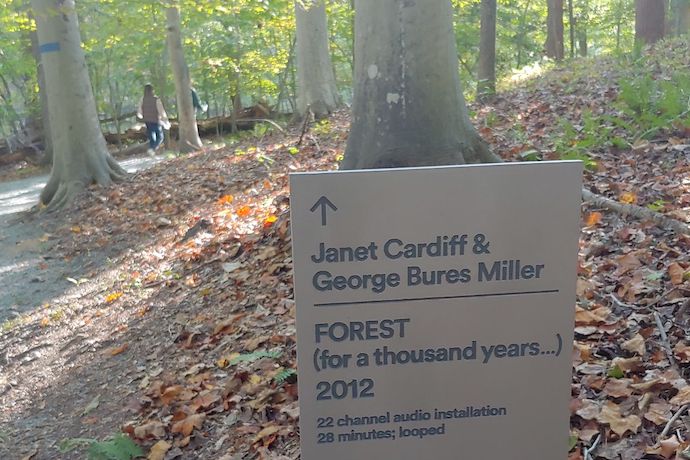
By Anna Lee Hirschi
Glenstone Museum, Maryland
A twig snap, a bird call, footsteps coming closer, then fading away. In a wooded clearing, a group of twenty people seated on stumps were facing different directions and listening so intently it looked like the scene had been paused. Not a single cell phone was out and there was no visual stimulation. On a balmy August day in a suburb of Washington, DC, the audio piece was in the middle of unfolding, recorded and ambient sounds indistinguishable. This is FOREST (for a thousand years…) (2012).
It is an outdoor audio installation by Janet Cardiff and George Bures Miller, at Glenstone Museum, in Potomac, Maryland. It is a twenty-eight minute audio track that plays across twenty-three speakers hidden in the forest that surround a clearing. FOREST (for a thousand years) runs on a loop for two hour-long periods, and while it is not exactly structured as a narrative, it contains the elements for an audience to construct one. The piece started with recorded forest sounds that seamlessly blended with the live sounds of the forest setting. These were interrupted by footsteps and a panting human breath, then horse hooves, a whiney and the rattle of a chain. Because they played across many speakers surrounding the clearing, sounds moved across the space, physically coming closer and moving away from listeners. A bang from a low speaker close to the edge of the grove was experienced differently than a hum from speakers in all directions, high up in the trees.
Forest (for a thousand years) continued to unfold with a low ambient thunder in the background. A horse neighed as it moved out of range, then the sound of many horses thundered through, fading to a single person’s footsteps. Voices yelled faintly in the distance. Quiet, briefly – then a bang, like a gunshot. Metal hit metal and a battle cry surrounded the clearing. The ancient sounds of war turned to modern ones, and the air filled with the drone of a plane, a long whistle, then an explosion and the rapid fire of an automatic weapon. This violence climaxed to a cacophony of explosions that enveloped the audience, and then ended suddenly. In its echo emerged the sweet sound of rain. Footsteps in the mud and heavy breathing moved into the foreground. With eyes shut, one could hardly believe it wasn’t raining, but the clearing remained sunny and still, the audience listening in rapt attention.
There is a loss of control with an experience like this: unlike visual art, you cannot shut your eyes or turn away from it. Unlike most composed music experienced in a concert hall, there is no way to anticipate what sound might come next, no musician’s gesture to watch for. The speakers are hidden around the circumference of the grove, and generate an unmediated experience of sound, provoking the body to flinch, in-take breath, or look reflexively towards the location of the hidden speaker.
Over the rain, voices entered, singing. Across the twenty two channels streamed polyphonic voices singing Arvo Pärt’s setting of the Latin canticle, Nunc dimittis. The singing increased in volume and proximity to the audience, starting above the clearing, and moving down to create an auditory dome as loud as the earlier sounds of war. Then, the voices moved out to the periphery of the clearing, to farther speakers, then started to fade. The hum of cicadas rolled in and out, alive in the clearing. The singing stopped, and like the moment after a composed piece is over but before the applause, the air hung heavy with all the sounds that had come before.
By description, FOREST (for a thousand years) is a collection of sounds, but in its execution, it becomes a profoundly moving document of human progress and regression; immersive, violent, and tender. ![]()